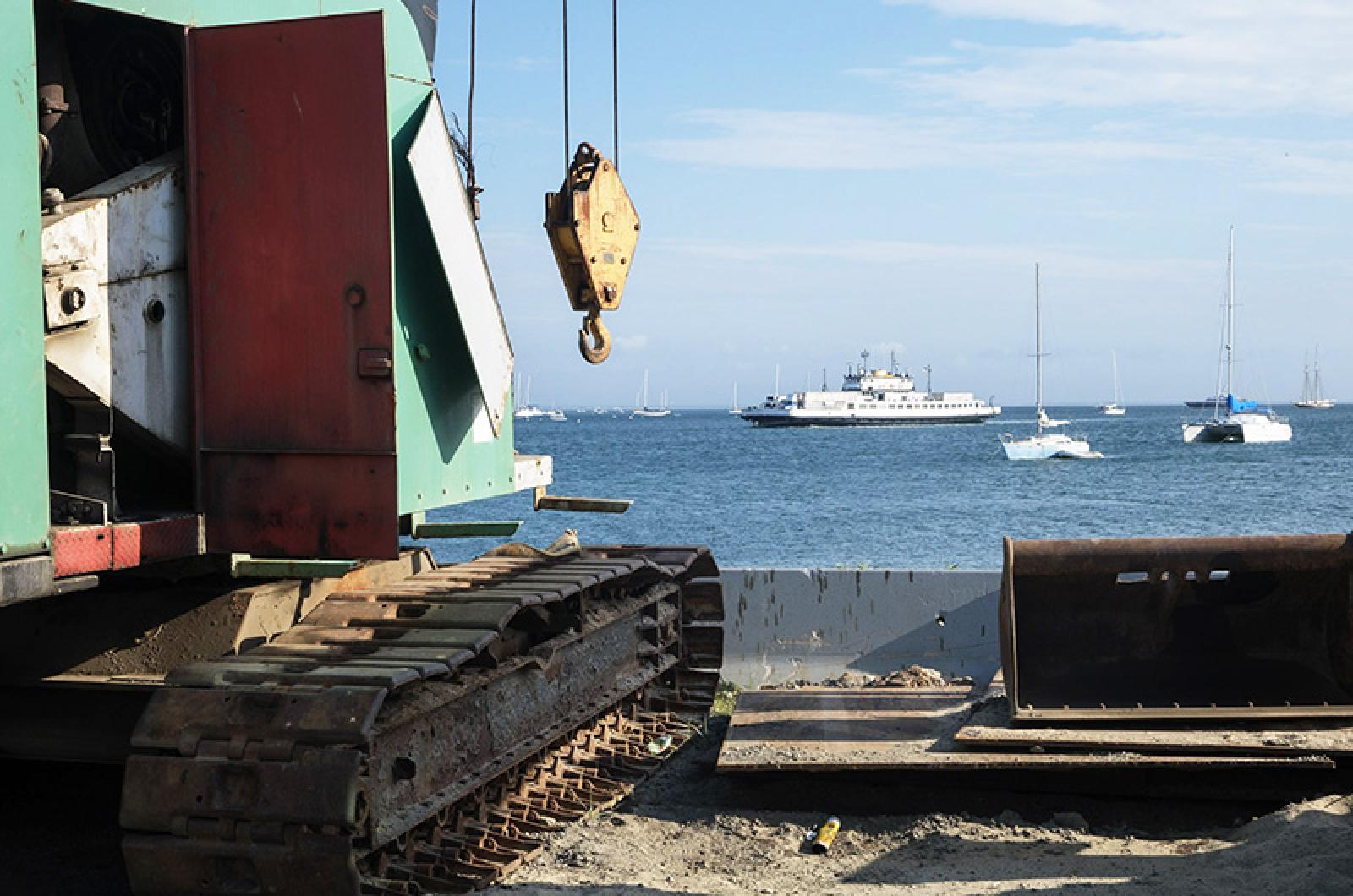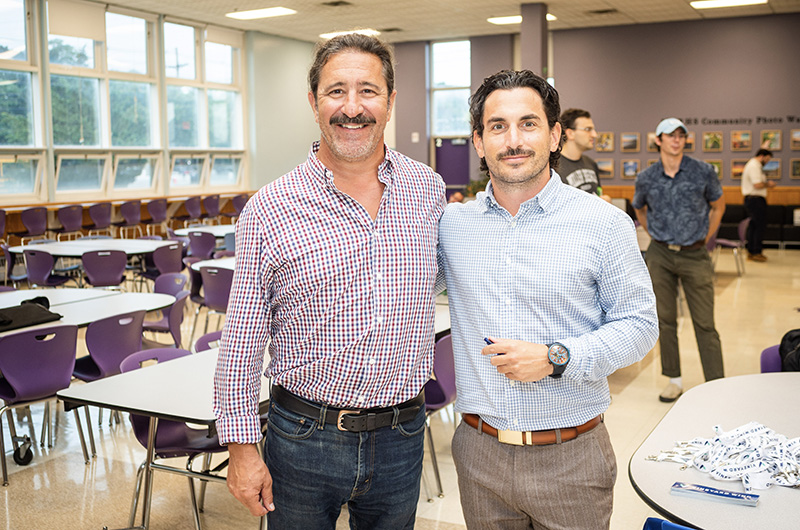Peyton Jeffers graduated from the Martha’s Vineyard Regional High School in June, but on Tuesday night he found himself back in the school cafeteria — this time scouting for a job.
The occasion was a job fair hosted by Vineyard Wind, the international conglomerate that is now poised to build the nation’s first commercial-scale wind farm 15 miles south of Martha’s Vineyard. Currently studying hydraulics through a joint program with Bristol Community College and the MV Center for Education and Training (MV CET), Mr. Jeffers hopes to be one of the first technicians to join the operations and maintenance team for Vineyard Wind 1.
“I have to jump on the opportunity,” he said. “They want the youth to be interested, and are actually providing a path for people to change things . . . It’s a sort of glimpse of hope for the future, just the fact that the world could be less dependent on fossil fuel than it currently is.”
Mr. Jeffers was one of about three dozen Islanders who came to the job fair, the second one hosted this year.
Vineyard Wind 1 plans to make the Island its operations and maintenance hub for the offshore wind development project. A trio of infrastructure projects — including the redevelopment of a waterfront pier at the Tisbury Marine Terminal, a new maintenance building on Beach Road in Vineyard Haven and a new 9,000-square-foot helicopter hangar at the Martha’s Vineyard Airport — have all now cleared or nearly cleared permissions at the local level. An Army Corps of Engineers permit is still needed for the marine terminal work, a spokesman for Vineyard Wind told the Gazette by email.
But if all goes according to plan, construction on the projects will begin by the end of the year, the spokesman said.
Communications spokesman Andrew Doba had initially expressed interest in organizing a meeting with the Gazette, but did not offer a time despite repeated requests over several weeks. Instead, he provided general answers on behalf of Vineyard Wind to questions posed by the Gazette in an email.
Vineyard Wind 1 is the first planned development from Vineyard Wind, a joint venture between Copenhagen Infrastructure Partners (CIP), a Danish investment firm, and Avangrid, an energy conglomerate that serves much of New England. With 62 turbines and an estimated budget of $2 billion, the project aims to bring 800 megawatts of power to southeastern Massachusetts — enough to power 400,000 homes or take 250,000 cars off the road, according to company estimates. New Bedford’s commercial seaport is the staging area for the construction phase of the project, also planned to begin later this year.
•
In documents filed with the Martha’s Vineyard Commission, Vineyard Wind has pledged to bring as many as 56 new jobs to the Island.
In an interview with the Gazette this week, Richard Andre, president of Vineyard Power, the Island energy cooperative that is Vineyard Wind’s community partner, emphasized that the positions created by Vineyard Wind would be year-round, “livable, working-wage” jobs.
“To rely disproportionately on . . . ways to make your money seasonally is really stressful on a community, it’s stressful on housing, it’s stressful on just working,” he said.
“These jobs are going to be around for 20 plus years,” he added. “It’s a real huge economic input to this Island.”
At the job fair Tuesday — which Mr. Andre and Vineyard Power helped organize — representatives from subcontractors General Electric and Semco Maritime along with Avangrid supplied information on positions ranging from administrators to turbine technicians to able seamen who will help operate the crew transfer vessels that will ferry technicians between the offshore turbines and the maintenance staging ground on the Vineyard Haven waterfront. The majority of the jobs will pay annual salaries of more than $80,000, according to documents filed with the MVC.
Less clear is how many workers hired for those jobs will live on the Island, and how many will commute.
On the Island, community partnerships for workforce training have included a collaboration among Vineyard Wind, MV CET and Bristol Community College. The program began in the fall of 2019 to train and certify wind turbine technicians. To date, the program has graduated eight students, MV CET executive director Holly Bellebuono told the Gazette in a recent interview.
“We’ve had everyone from landscapers and gardeners to a chef who was in the culinary world and decided he wanted to change,” Ms. Bellebuono said. “These are primarily people who are completely shifting their career course.”
Ms. Bellebuono said she hopes to attract more people to the program. She admitted that communications have been difficult at times between her organization, which is the adult education training program on the Island, and the corporate entities contracted by Vineyard Wind.
•
At the job fair Tuesday, onboarding schedules were detailed that would see the first local technicians hired in the first quarter of 2023, with hiring of more technicians and administrative positions to continue through 2024, when the wind farm is expected to be fully operational.
Mr. Andre said in addition to promoting local hiring, Vineyard Power has used its position as a community partner to negotiate a series of benefits that will ensure the milk and honey of the wind farm stays close to the Island.
First among these is $7.5 million in benefits to be delivered by Vineyard Wind over the next 15 years — amounting to about $500,000 annually.
According to Mr. Andre, 40 per cent of that funding will go directly toward reducing the electric bills for low-income ratepayers registered with Cape Light Compact, an energy aggregator for the Cape and Martha’s Vineyard.
Low-income ratepayers are defined as those who earn less than 60 per cent of the median income for the region, Mr. Andre explained. About 600 Island residents are currently registered as low-income ratepayers, although that number could increase as awareness of the community benefits program grows, he said.
“We . . . are going to be doing a lot of outreach to make sure that people are aware of the program,” Mr. Andre said. “We’re going to put money in their pockets . . . and we’re going to reduce their electricity bill.”
The price cuts will likely begin by the end of this year, he said.
The remaining 60 per cent of the community benefits funding will go toward creating resiliency in more than 30 critical facilities previously identified by Island towns and nonprofits.
“A critical facility could be the Tisbury water department or the Edgartown wastewater treatment facility,” Mr. Andre said. He also listed the Tisbury School and town emergency shelters, like the West Tisbury Library.
The facilities will receive funds to buy new battery and solar technologies designed to support self-sufficiency in the event of a natural disaster or other emergency.
•
When Vineyard Power and Vineyard Wind signed the community benefits agreement in 2015, they also pledged to explore ways for Vineyard Power to buy long-term energy contracts from Vineyard Wind, to lower the price of renewable energy for local ratepayers.
At the time, such a purchase would have violated state energy laws. But that changed in August of this year, when the Massachusetts legislature passed a bill that will allow Cape Light Compact to buy long-term contracts directly from renewable developers. Mr. Andre said Vineyard Power had a strong hand in drafting the bill.
“What that . . . enables is us to buy offshore wind from the offshore wind companies directly,” with Cape Light Compact as a kind of procurer, he said.
But with demand for renewable energy high (and the sale of long-term contracts helping to pay for construction on offshore wind projects), he said Vineyard Wind has already sold its planned 800 megawatts to regional energy groups.
Still, he remained confident that the Vineyard ratepayers will soon have access to affordable renewable energy through one of the other wind farms, like Mayflower Wind, planned for the outer continental shelf. He added that Vineyard Power could also purchase long-term energy contracts if Vineyard Wind overproduces.
“I feel really optimistic that you know, in the next couple of years, we will be able to directly purchase offshore wind [energy] from one of the developers,” Mr. Andre said.








Comments (13)
Comments
Comment policy »